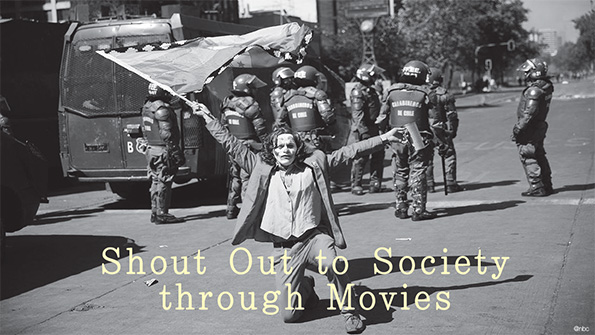
Recently, movies that spotlight social issues have been gaining huge popularity from the public. Movies about problems not only provide fun and excitement but also encourage the audience to recognize social problems and show what might happen in reality. CBT researched the characteristics of these movies and some of the leading social problem movies. –Ed
Movies have the power to change society. Movies influence the audience by stimulating imagination and thoughts as well as communicating visual and auditory information through a video. Audiences evaluate movies and alter their social behaviors by absorbing what directors portray and what they want to say to society. Therefore, movies can change society by having a direct or indirect effect on it. The changes can touch on economic or legal issues, or they can cause conflicts among members of society. As such, movies are closely connected to the changes in our lives, and they create many social effects. Among them, movies that criticize society are the ones that have maximized this effect. The definition of a social problem movie is a movie made to expose the negative aspects of society such as crime or absurdity. In other words, directors produce films that focus on the negative aspects of society, but they also want the audience to recognize social problems and behave with a social conscience. This is possible because these movies reflect reality in the film, which helps the audiences begin to empathize, grieve or speak out.
Many social phenomena have arisen since the introduction of these movies. Public interest in the punishment of sex crimes against children or the disabled has arisen since the release of the movie Dogani, which deals with the sexual assault of disabled children, in September 2011. The public was shocked that the film was based on a real case and demanded a reinvestigation into the case. As a result, the Dogani Act was enacted in November 2011, and it increased the severity of punishment and the statute of limitations for sex crimes against children or the disabled through a signature campaign. Also, there is a growing public interest in the recently released movie Black Money. Black Money is a movie about Lone Star Gate, which was about the sale of Korea Exchange Bank at a giveaway price by Lone Star Funds. Since the release of the movie Black Money, many people have become interested in Lone Star Gate, which they had forgotten about or were not aware of, and the ongoing lawsuit against Lone Star Funds has drawn more attention. Lee Jeong-u(’16, Dept. of International Business) said, “I didn’t know about Lone Star Gate until I saw the movie. At the end of the movie, I found out that the movie was based on a true story, so I looked up the event. There were some exaggerated elements in the movie, but the movie was meaningful in that people were rethinking and re-focusing on the forgotten incident.” As such, social problem movies play an important role in that they serve as momentum for the audience to pay attention to social issues or problems, to discuss cases and to urge people to speak out about problems.
Among the many movies that have recently been released and have received many favorable responses from audiences, movies that criticize society account for a considerable portion. Many social problem movies are currently hitting the Korean movie market, including Parasite (2019.05.30.), Joker (2019.10.2.), Kim Ji-young, Born in 1982 (2019.10.23) and Black Money (2019.11.13.).
The public’s attention has shifted to social problem movies because they are based on reality. They are a movie version of what happened in real life or what might happen in real life, which can evoke deep sympathy or fury from the audience. They also can get pleasure by watching the problems getting solved or seeing the characters cope with adversity. They also offer a chance for viewers to rethink social issues after the screening. Joker has set a huge box-office record around the world, creating Joker Syndrome. The movie Joker has spotlighted the gap between the rich and poor in society, the cold reality of the underprivileged and the conflict between social classes. Audiences have realized that anyone in society can become a Joker by substituting the real world for Gotham City in the movie. In fact, after the screening of the movie Joker, Joker masks and makeup appeared in demonstrations all around the world. In Chile, Hong Kong, and Lebanon, Jokers appeared in anti-government and anti-rich protests, using masks as a tool to inform the governments of their resistance. As such, social problem movies have helped audiences to focus on our actual societies, to think about social issues and to express their opinions about real issues. Kim Dong-shin(’15, Dept. of International Business) said, “I’m trying to show children who have been alienated that we love them, so I’m doing volunteer work to teach them, while also remembering that there are no differences between children and us after watching the movie. It is our task to make a loving and caring society that does not marginalize people around us.”
Another reason people are enthusiastic about social problem movies is that they have a slightly different world from reality. One of the main purposes of a movie is to generate profits, so the social problem movies express an exaggerated reality through the director’s imagination and directing for fun. The exaggerated reality can maximize emotions from the audience. This is well illustrated by the movie Parasite, which has won great acclaim in the global film market with more than 10 million viewers in Korea alone. The movie Parasite portrayed the polarization of society through the gap between rich and poor in a way that is more exaggerated than in reality. It seems like reality, but by depicting the extreme ‘the rich-get-richer and the poor-get-poorer phenomenon’ implicitly, it has maximized the unpleasant emotions of the audiences. This facilitated a sharper bitterness from the audience concerning the gap between the rich and poor.
Due to these various factors, social problem movies are gaining the attention of audiences around the world by reporting problems and absurdities in society and by further encouraging people to participate in society. Attention is being paid to the importance of social problem movies to make our society a better society.

By Yoo Jin-kyu | jk37@cbnu.ac.kr



 All
All Campus News
Campus News Society & Global
Society & Global People
People Feature
Feature Experience
Experience Column
Column Culture
Culture Cartoon
Cartoon Photo News
Photo News All
All Culture
Culture






 Yoo Jin-kyu
Yoo Jin-kyu











